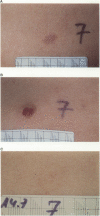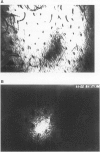Abstract
Indocyanine green (ICG) is clinically approved for the determination of liver function, cardiac output and plasma volume. In this pilot study, ICG was used as photosensitizer in combination with a diode laser to treat AIDS-associated Kaposi's sarcoma (KS) in three patients. Directly and up to 50 min after intravenous administration of ICG (2-4 mg kg(-1) body weight), KS (n=57), mainly plaque-type, were irradiated using a diode laser (lambda em=805 nm, 100 J cm[-2], 0.5-5 W cm[-2]) matching the absorption maximum. Complete remission of KS (n=16) was achieved when irradiated 1-30 min after injection of the second dose of ICG (2 x 2 mg kg(-1) b.w., 30 min apart) with 3-5 W cm(-2) and 100 J cm(-2). Biopsies (n=3) revealed necrosis of the tumour 24 h and complete remission 4 weeks after therapy. In general, systemic side-effects were not observed and cosmetic results were very good. However, hyperpigmentation occurred temporarily in lesions located on the lower extremities. These findings show that AIDS-associated KS can be effectively treated after photosensitization with ICG and subsequent irradiation with an appropriate diode laser. However, additional investigations need to elucidate the exact mechanism of action of ICG-mediated phototherapy and have to show the efficacy for the treatment of other highly vascularized solid tumours.
Full text
PDF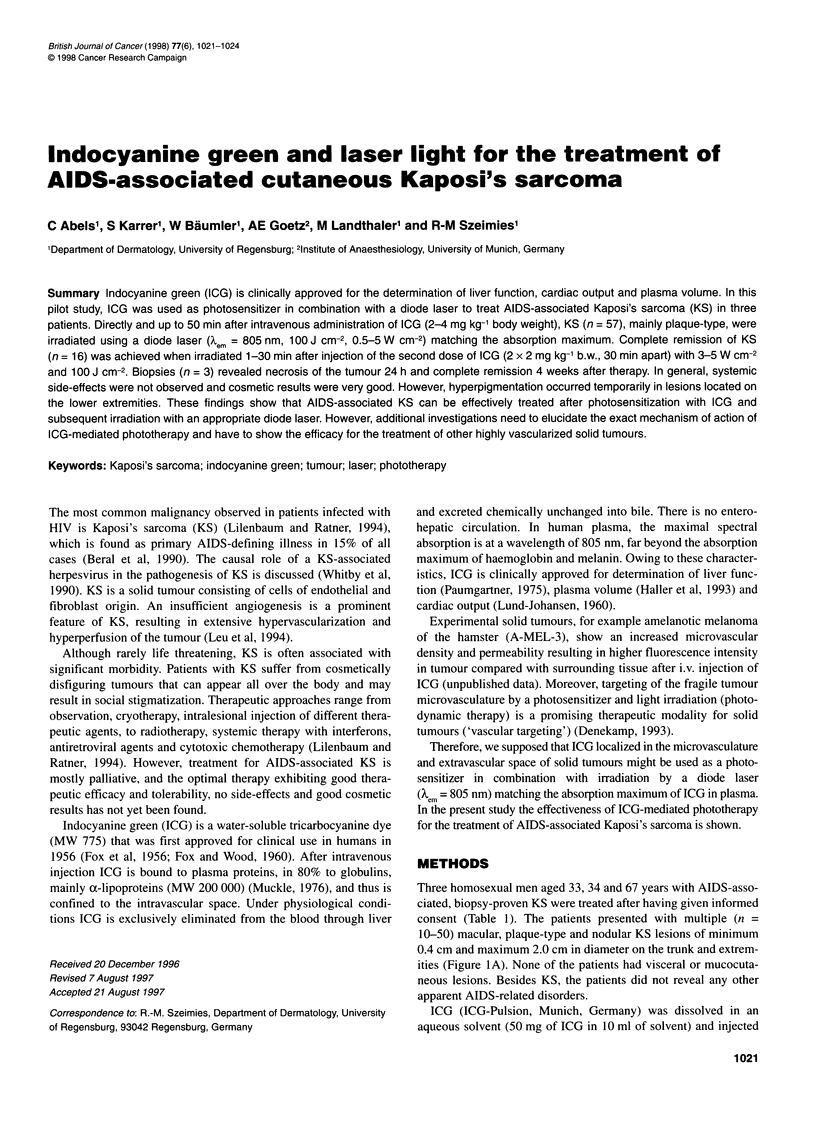
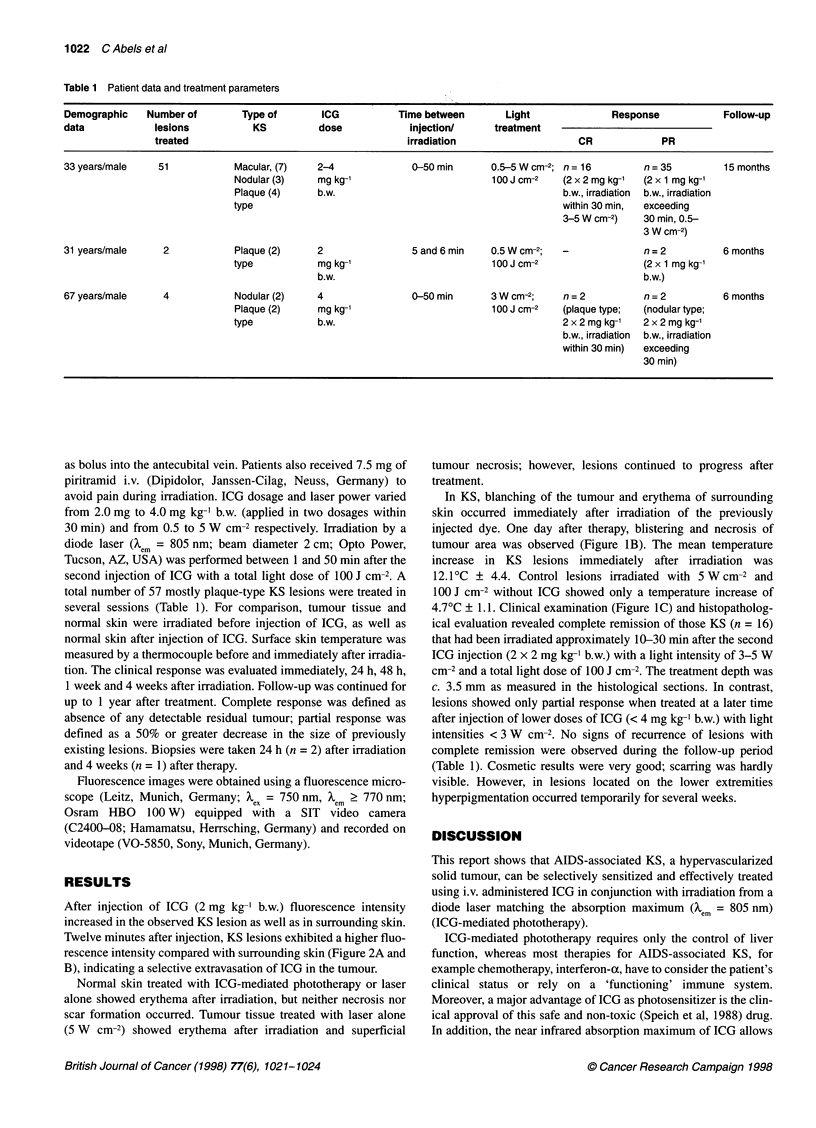
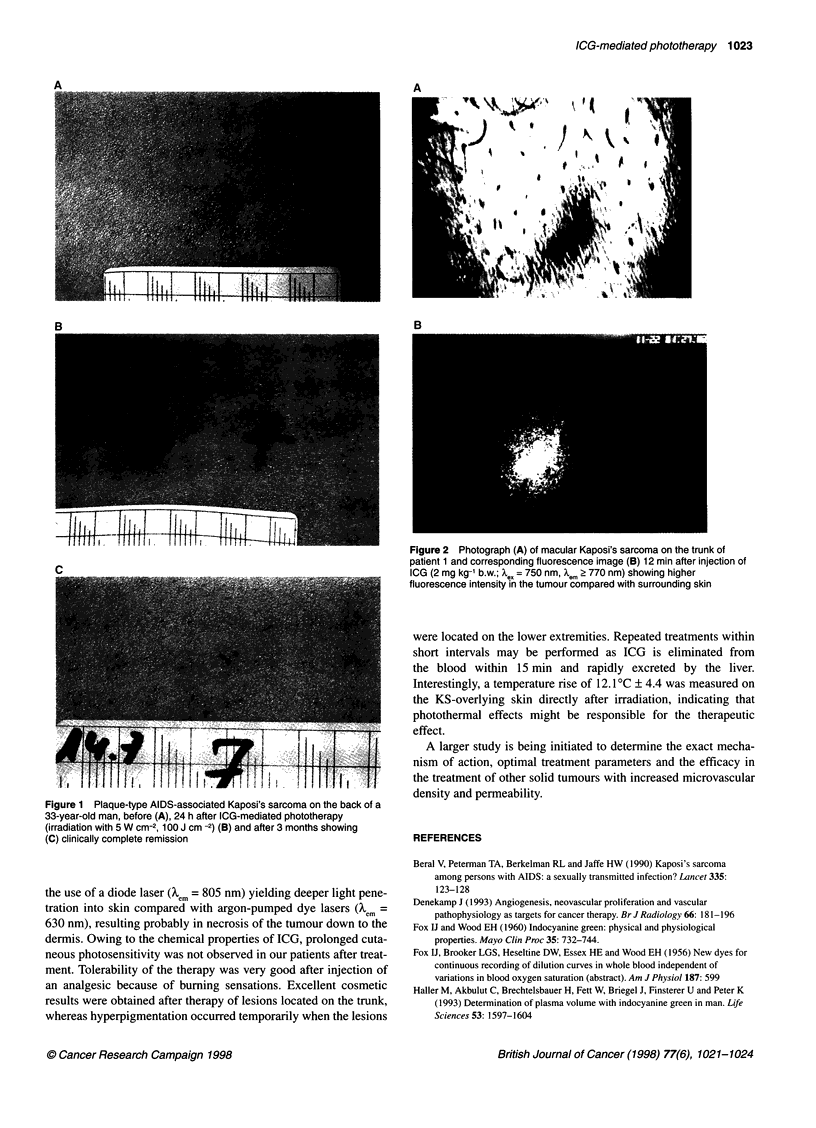

Images in this article
Selected References
These references are in PubMed. This may not be the complete list of references from this article.
- Beral V., Peterman T. A., Berkelman R. L., Jaffe H. W. Kaposi's sarcoma among persons with AIDS: a sexually transmitted infection? Lancet. 1990 Jan 20;335(8682):123–128. doi: 10.1016/0140-6736(90)90001-l. [DOI] [PubMed] [Google Scholar]
- Denekamp J. Review article: angiogenesis, neovascular proliferation and vascular pathophysiology as targets for cancer therapy. Br J Radiol. 1993 Mar;66(783):181–196. doi: 10.1259/0007-1285-66-783-181. [DOI] [PubMed] [Google Scholar]
- FOX I. J., WOOD E. H. Indocyanine green: physical and physiologic properties. Proc Staff Meet Mayo Clin. 1960 Dec 7;35:732–744. [PubMed] [Google Scholar]
- Haller M., Akbulut C., Brechtelsbauer H., Fett W., Briegel J., Finsterer U., Peter K. Determination of plasma volume with indocyanine green in man. Life Sci. 1993;53(21):1597–1604. doi: 10.1016/0024-3205(93)90183-4. [DOI] [PubMed] [Google Scholar]
- Leu A. J., Yanar A., Jost J., Hoffmann U., Franzeck U. K., Bollinger A. Microvascular dynamics in normal skin versus skin overlying Kaposi's sarcoma. Microvasc Res. 1994 Jan;47(1):140–144. doi: 10.1006/mvre.1994.1009. [DOI] [PubMed] [Google Scholar]
- Lilenbaum R. C., Ratner L. Systemic treatment of Kaposi's sarcoma: current status and future directions. AIDS. 1994 Feb;8(2):141–151. [PubMed] [Google Scholar]
- Lund-Johansen P. The dye dilution method for measurement of cardiac output. Eur Heart J. 1990 Dec;11 (Suppl 1):6–12. doi: 10.1093/eurheartj/11.suppl_i.6. [DOI] [PubMed] [Google Scholar]
- Muckle T. J. Plasma proteins binding of indocyanine green. Biochem Med. 1976 Feb;15(1):17–21. doi: 10.1016/0006-2944(76)90069-7. [DOI] [PubMed] [Google Scholar]
- Paumgartner G. The handling of indocyanine green by the liver. Schweiz Med Wochenschr. 1975;105(17 Suppl):1–30. [PubMed] [Google Scholar]
- Speich R., Saesseli B., Hoffmann U., Neftel K. A., Reichen J. Anaphylactoid reactions after indocyanine-green administration. Ann Intern Med. 1988 Aug 15;109(4):345–346. doi: 10.7326/0003-4819-109-4-345_2. [DOI] [PubMed] [Google Scholar]
- Whitby D., Howard M. R., Tenant-Flowers M., Brink N. S., Copas A., Boshoff C., Hatzioannou T., Suggett F. E., Aldam D. M., Denton A. S. Detection of Kaposi sarcoma associated herpesvirus in peripheral blood of HIV-infected individuals and progression to Kaposi's sarcoma. Lancet. 1995 Sep 23;346(8978):799–802. doi: 10.1016/s0140-6736(95)91619-9. [DOI] [PubMed] [Google Scholar]



